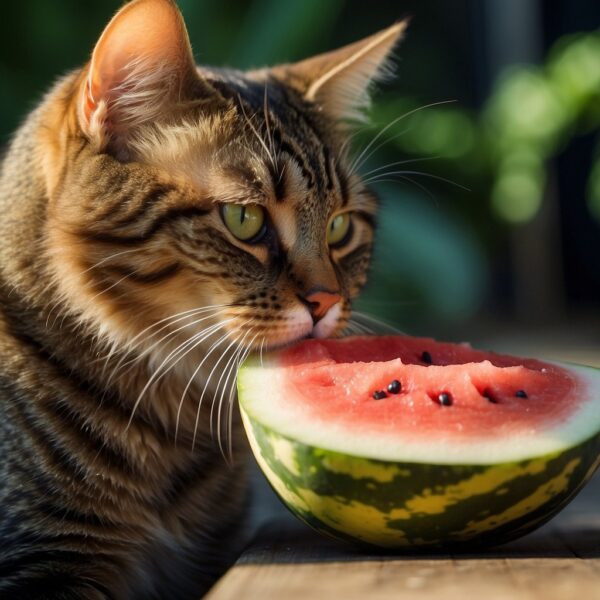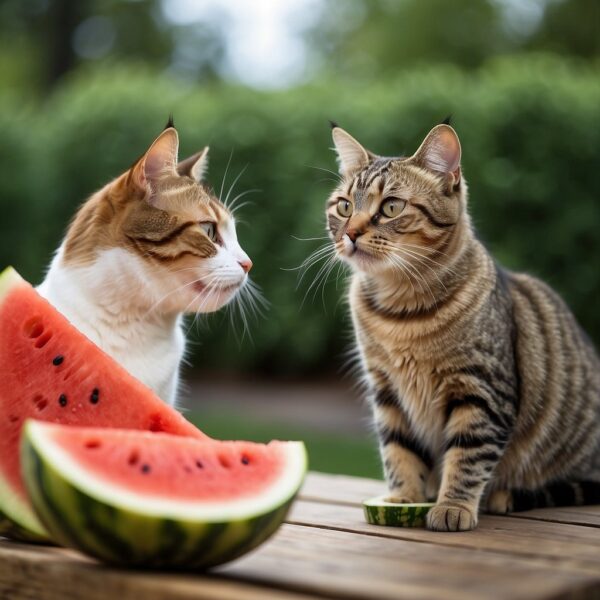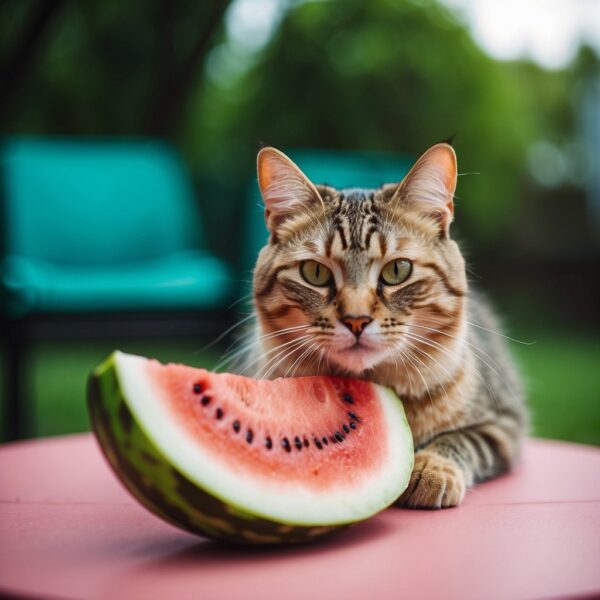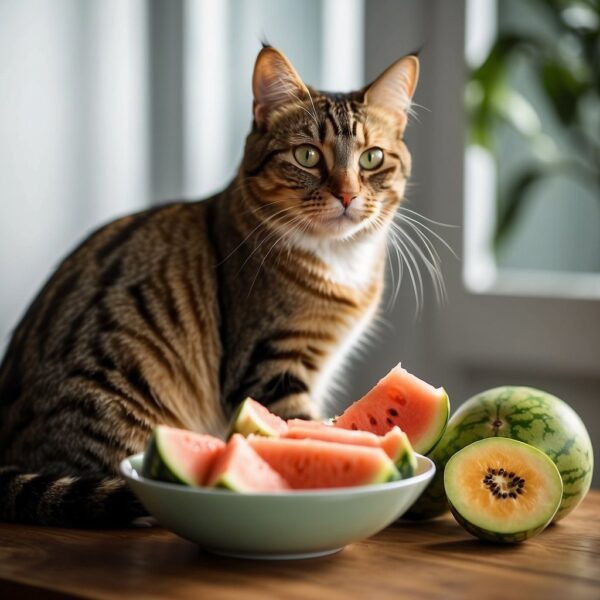
Cats and Watermelon
As a cat parent you might wonder if it’s safe for your cats to nibble on watermelon. Watermelon is not toxic to cats and is considered generally safe in small amounts. This juicy fruit, which is a staple in many human diets, especially during the warmer months, can sometimes be offered as a treat to cats. Yet, it’s important to recognize that cats have different dietary needs from humans. Their digestive systems are not designed to handle a lot of fruits and vegetables, and watermelon is no exception.
While watermelon is safe for most cats, there are potential health risks involved. Cats that have diabetes or are overweight should avoid watermelon due to its sugar content. Even for healthy cats, eating watermelon in excess can lead to digestive upset, such as vomiting or diarrhea. Therefore, it’s important for cat parents to understand the nutritional impact of watermelon and to serve it in moderation. Additionally, as obligate carnivores, cats do not require fruits for nutritional purposes; their diet should be primarily composed of high-quality protein.
Key Takeaways
- Watermelon is non-toxic and can be offered to cats in small portions.
- Overconsumption of watermelon may lead to digestive distress or other health issues in cats.
- As carnivores, cats do not need fruits like watermelon in their diet and should consume them only as occasional treats.

Health Benefits and Risks of Watermelon for Cats
Watermelon offers both nutritional benefits and potential health risks for cats. While it can serve as a source of hydration and certain nutrients, it’s important to balance this with concerns about sugar content and digestive issues.
Nutritional Content of Watermelon
Watermelon is rich in water and can help keep cats hydrated, especially during hot weather. The flesh of the watermelon contains vitamin A, vitamin C, and potassium. It also provides lycopene, an antioxidant that can contribute to overall health. The fruit is low in calories, which can be beneficial for maintaining a healthy weight.
- Vitamins: Essential for immune system and vision.
- Potassium: Supports nerve function and muscle health.
- Antioxidants: Combat harmful free radicals in the body.
- Hydration: Aids in preventing dehydration.
Risks and Considerations
While watermelon is non-toxic to cats, there are several considerations to take into account before offering it as a treat.
- High Sugar Content: Watermelon contains natural sugars which could be problematic for cats with diabetes or those that are overweight.
- Choking Hazard: Watermelon seeds can cause choking or lead to intestinal blockages.
- Digestive Issues: Some cats might experience vomiting or diarrhea due to the sugars and fiber content.
- Portion Control: Excessive consumption can lead to disruption in normal diet and nutritional imbalances.
Feeding your cat the rind or allow them to ingest watermelon seeds can be harmful. The rind can cause digestive issues and seeds may lead to intestinal blockage.
Appropriate Portions and Frequency
When offering watermelon as a treat, it’s important to do so in moderation and not as a part of their daily diet.
- Occasional Treat: A small piece of watermelon can be a nice treat on a warm day.
- Seedless and Rindless: Always remove seeds and rind to avoid health risks.
- Moderation: Treats should make up no more than 10% of a cat’s daily caloric intake.
By offering appropriately sized portions of seedless watermelon flesh on an occasional basis, you can provide a safe and enjoyable treat for your cat.

Practical Guidelines for Feeding Watermelon to Cats
When offering cats watermelon, it’s important to prepare it correctly to avoid health risks and to be aware of any adverse reactions.
Preparing Watermelon for Safe Consumption
Firstly, remove all seeds from the watermelon as they can be a choking hazard. Cats can safely eat the flesh of the melon, but always in moderation. The fruit’s high water content can be refreshing, but it’s not a necessary part of a cat’s diet. The rind should be avoided since it can be tough on a cat’s digestive system and may lead to an upset stomach. You might opt to offer your pet small pieces of fresh watermelon or even frozen watermelon as a cool treat during hot weather. However, it is crucial to keep it to a minimum to prevent gastrointestinal issues.
- Step by Step Preparation:
- Step 1: Choose a ripe seedless watermelon.
- Step 2: Thoroughly wash the melon’s outer surface.
- Step 3: Slice the melon and remove the rind completely.
- Step 4: Ensure no seeds are present in the pieces.
- Step 5: Cut the flesh into small, manageable pieces for your cat.
- Step 6: Offer a small piece to your cat as a treat, not a meal replacement.
Signs of Allergic Reactions or Intolerances
If a cat shows signs of an allergic reaction after eating watermelon, such as vomiting or diarrhea, it should not be given the fruit again. Cats can have intolerances just like humans, and these can manifest in minor gastrointestinal issues or more severe upset stomachs. If your cat has a known health condition, such as diabetes, or is overweight, consult your veterinarian before giving any melon, as it can cause sugar fluctuations.
- Symptoms to watch for:
- Disinterest in food
- Changes in behavior
- Gastrointestinal discomfort
- Vomiting
- Diarrhea
- Swelling or hives (in rare cases)
Always observe your cat closely after introducing any new treat into their diet, and consult with a vet if you notice concerning symptoms.

Safe Alternatives to Watermelon
While watermelon can be occasionally safe for cats, there are other fruits and vegetables that can also serve as healthy treats. These alternatives provide essential nutrients and hydration without the high sugar content found in watermelon.
Fruits and Veggies Fit for Feline Consumption
Cats can safely enjoy a variety of fruits and vegetables in moderation as treats. However, cat owners should be aware that cats require a high-protein, low-carbohydrate diet that is predominantly meat-based. Here’s a list of cat-friendly options:
- Apples (peeled and seedless): Good source of vitamins A and C.
- Blueberries: Antioxidant-rich and can be given frozen or fresh.
- Strawberries: Full of fiber and vitamin C, but should be given sparingly due to sugar content.
- Bananas: A small piece can offer potassium and soluble fiber.
- Pumpkin: Excellent for digestion, it’s high in fiber and low in calories.
- Peas: Often found in commercial cat foods, peas provide vitamins and fiber.
- Carrots: When cooked and chopped, they are a good source of beta carotene and vitamins.
- Green bell peppers: Low in calories and can be a crunchy treat offering hydration.
- Zucchini: This veggie is safe for cats and is a source of magnesium and potassium.
These alternatives should be served in small, bite-sized pieces and without any added sugars, salts, or fats.
Creating a Balanced Treat Menu
Treats should never make up more than 10% of a cat’s daily calorie intake to maintain a healthy balance. Here are tips for including these safe alternatives into a cat’s diet:
- Measure Treat Portions: Use a measuring spoon or scale to ensure appropriate portion size.
- Mix with Regular Food: Incorporating veggies like pumpkin or peas into their regular food can boost fiber intake.
- Introduce Slowly: To prevent digestive upset, introduce new treats gradually.
- Observe Reactions: Monitor the cat’s response to new treats, looking out for any signs of discomfort or allergies.
Remember, while fruits and vegetables can be a healthy part of a cat’s diet, core nutrition should come from high-quality commercial cat foods tailored to their carnivorous needs.

Consultation with a Veterinary Professional
When considering adding watermelon or any treats outside of a cat’s regular diet, consulting a veterinarian is vital. A veterinarian can advise whether watermelon is a suitable treat for an individual cat, taking into account the cat’s health condition and dietary needs.
Cats have specific dietary requirements, and although watermelon is non-toxic, it is not a necessary part of their diet. Treats like watermelon should only be a small portion of a cat’s caloric intake to prevent obesity and should not replace cat food or a prescription diet without a veterinarian’s approval.
Diabetic cats or those with certain health issues may need to avoid watermelon due to its sugar content. A professional can provide guidance based on the latest veterinarian research on what is safe and beneficial for a cat’s health.
Before introducing any new food, always consult with a veterinary professional to ensure it aligns with the best interests of the cat’s health and well-being.
We offered watermelon for Annie, Eddie and Mercy. See their reactions in this short video.
Frequently Asked Questions
Cats can enjoy watermelon as an occasional treat. This section addresses common concerns about feeding watermelon to cats, including the safety of specific parts of the fruit and the frequency of feeding.
Can cats consume watermelon seeds safely?
No, cats should not eat watermelon seeds. Seeds can cause intestinal blockages and might contain harmful chemicals. It’s best to remove the seeds before giving watermelon to cats.
Is it safe for cats to eat watermelon rind?
The rind of a watermelon is not toxic to cats, but it is hard and difficult to digest. To prevent choking or gastrointestinal issues, it’s advisable to offer only the flesh to cats.
How often can cats have watermelon?
Cats can have watermelon in moderation, which means occasionally and in small quantities. Overfeeding can lead to digestive upset or contribute to obesity.
What fruits are safe for cats to eat?
Several fruits are safe for cats in moderation, including apples (without seeds), bananas, and blueberries. Always ensure fruits are washed, peeled, and seedless before offering them to a cat.
Are there any fruits that are poisonous to cats?
Yes, some fruits are toxic to cats, such as grapes and raisins, which can cause kidney damage. It is also recommended to avoid citrus fruits like lemons and oranges, as they can cause stomach upset.
Can cats have watermelon juice?
Cats may have small amounts of watermelon juice; however, since it lacks fiber compared to the fruit’s flesh and might contain added sugars, it’s advisable to stick to offering the solid parts of the fruit itself.